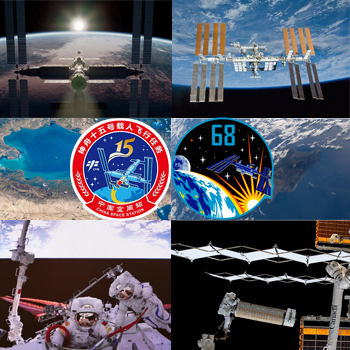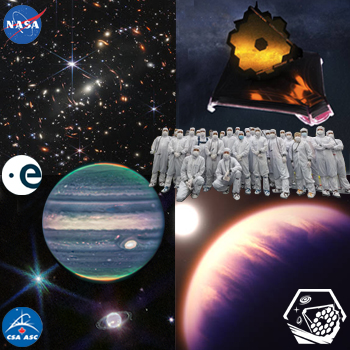Earth’s 2 Human Outposts in Space Busy with Station Upgrades, Experiments in Biology, Material Science, Astronomy
|
MONDAY☆ Dec 19 — ISS, ~415-km LEO: Six craft docked to ISS for Expedition 68 seven-member crew are human-rated Soyuz MS-22 and Crew-5 Dragon, and cargo ships Progress 81 + 82P, Cygnus 18, Dragon CRS-26 which flew a total of ~ 27,002 kg of cargo. ☆ Dec 19 — Tiangong Space Station, ~390-km LEO: Shenzhou 15 three-member crew working to set up additional experiments in current configuration of 24 experiment cabinets and a payload airlock. Highlights… o NewSpace: Relativity Space 3D printed Terran 1 rocket on LC-16 at CCSFS awaiting FCC launch license and final static fire; SpaceX to offer employee-owned shares at US$77 for $140B valuation; Planet predicts 2022 FY revenue of $188-$192M, a promising sign of financial stability. ☆ Solar System: SpaceX dearMoon circumlunar crew includes 4 USA, 2 Japan, and 1 S. Korea, Czech Republic, UK, Ireland, India members; Study of meteoroid recovered in AB, Canada suggests Oort Cloud contains levels of rocky material at odds with dominant solar system formation theory. ☆ Galaxy: 1,000 supernovas identified by Caltech algorithm SNIascore within ZTF / Palomar Observatory data highlights usefulness of AI in astronomy; JWST observations date red spiral galaxies RS13 and RS14 to 8-10 billion years old, suggesting spiral galaxies formed in earlier than previously thought. o Global: Nigeria and Rwanda are 22nd, 23rd signatory nations to Artemis Accords; USSF unit now stationed at Osan Air Base 65-km south of Seoul, S. Korea; Neutron, New Glenn, Starship, Terran 1 and Vulcan race to be first methane-fueled orbital vehicle following Landspace Zhuque-2 upper stage failure. ● USA: Boeing to increase SLS manufacturing footprint at KSC with goal of producing 2 cores / yr; Sian Proctor to serve as Explore Mars Astronaut Ambassador; UArizona Center for Human Space Exploration conducting training programs at Biosphere 2. ● Hawai’i: Mauna Kea Stewardship and Oversight Authority member Rich Matsuda heralds “new model of astronomy that does not insist on control”; University of Bern study finds climate change will increase moisture content of atmosphere above Hawaii, Chile, Canary Islands, degrading observations. |
 |
● = Terrestrial and… o = International terrestrial events
☾ = Moon activity ★ = Space and… ☆ = International space / astro events in Hawaii Standard Time unless noted. Add 10 hours to obtain UT (‘Universal Time’). |
Weekly Planet Watch – Evening Planets: Mercury (SW), Venus (SW), Mars (E), Jupiter (S), Saturn (SW), Uranus (S), Neptune (W).
JWST Surpasses 1st Year in Space While Studying Solar System, Earliest Galaxies, Exoplanet Atmospheres
The 21st Century Hubble Telescope successor, James Webb Space Telescope, will begin its 2nd year in space since December 25, 2021 launch while continuing its impressive and influential observations from halo orbit around Sun-Earth L2 (~1.5M km from Earth). The international NASA / ESA / CSA-ASC infrared telescope with 6.5-meter primary mirror and 4 science instruments (Mid-InfraRed Instrument, Near InfraRed Spectrograph, Near InfraRed Camera, Near Infrared Imager and Slitless Spectrograph) is observing in wavelengths from 0.6 (orange light) to 28.3 (mid infrared) μm (micrometers). The mission reached the 5-month mark (Dec 11) for full science operations in which 460 hours of observing time for 13 programs was allotted to investigate Jupiter and its moons, organic molecules around infant stars, supermassive black holes, and galaxies born in the early universe. Located 39 LY from Earth, scientists are looking forward to analyzing the JWST observations of the 7-planet Trappist-1 system for atmosphere / habitability potential. All of JWST data may become immediately available, possibly in 2025, per recent NASA considerations after USA White House Directive. Designed for at least 5.5 years, the hope is US$10B JWST will have a 10-year lifetime, while its results inspire generations to come. An estimated 20,000 people contributed to JWST development over 20+ years, including Bill Ochs who has been the project manager since 2011. (Image Credits: NASA, ESA, CSA-ASC, STScI) |
☆ NET Dec 19 — ISS, U.S. EVA #83, ~405-km LEO: Expedition 68 crew Rubio and Cassada to install an IROSA (ISS Rollout Solar Array) on port 4 truss at International Space Station; starts 07:20 EST, live coverage available. ☆ Dec 19 — Gaia, Sun-Earth L2 Lagrange Point: ESA spacecraft reaches 9 full years / enters 10th year in space today; now in extended mission phase working to map more than 1 billion stars; launched in 2013. ● Dec 19, 20 — Tarleton State University Planetarium, Stephenville TX: Mystery of the Christmas Star Planetarium Show; examines recorded sightings of significant astronomical events to explain the Star of Bethlehem. Continued From… ● Oct 15 – Jun 15, 2023 — International Space Elevator Consortium, Online: Space Elevator Academic Challenge: Improving Humanity’s Future; for students 17-25. ● Oct 29 – Dec 31 — Canada-France-Hawaii Telescope, W. M. Keck Observatory, Maunakea Observatories, Kamuela HI: Waimea Solar System Walk for 2022; combining in-person and self guided walks, along Ala ‘Ōhi’a Road. ● Nov 14 – Jan 17, 2023 — Wichita State University, Wichita KS and Online: Registration Open for 2023 Interstellar Seminar ‘LASI 150G’; 1-credit hour seminar which begins Jan 18, every Wednesday 14:30-15:20, led by Prof. Mark Schneegurt. ● Dec 1 – Jan 31, 2023 — JPL, NASA, Online / Pasadena CA: Prepare for the Science Fair; video series for students in grades 3-12, teachers and parents. ☾ Dec 11 – Apr 25, 2023 — Hakuto-R / ispace Mission 1, Lunar Landing Trajectory: Carrying UAE Rashid 10-kg rover, 0.25-kg JAXA rover, Hakuto-R performing orbital control maneuvers to reach Lunar Orbital Insertion, followed by Moon touchdown nominally ~4.5 months after launch. ☆ NET Dec 16 — Virgin Orbit, Launch Cosmic Girl / LauncherOne / ‘Start Me Up’ mission, Spaceport Cornwall, United Kingdom: Cosmic girl aircraft to lift LauncherOne to launch 9 payloads to LEO in 1st launch from UK. o Dec 15-24 — National Space Foundation, NOIRLab, International Dark-Sky Association, AURA, Online / Global: Globe at Night December Campaign; campaign to raise awareness of light pollution by inviting citizen-scientists to measure & submit night sky brightness observations (goal 20,000 data points for 2022). ☾ Dec 17-29 — Korean Pathfinder Lunar Orbiter ‘Danuri’, Lunar Orbit: Danuri to perform 5 orbital insertion maneuvers to achieve 100-km polar orbit. |
TUESDAY
☆ Dec 20 — Arianespace, Launch Vega-C / Pléiades Neo 5 & 6, Kourou, French Guiana: Arianespace Vega-C rocket to launch Pléiades Neo 5 and 6 Earth observation satellites for Airbus.
● Dec 20-24 — ʻImiloa Astronomy Center, Hilo HI: Showings of Mystery of the Christmas Star.
☆ Dec 20 — Apollo Asteroid 2014 HK129: Near-Earth Flyby (0.017 AU)
☆ Dec 20 — Apollo Asteroid 2020 GE: Near-Earth Flyby (0.072 AU)
WEDNESDAY
☆ Dec 21 — ISS, Russia EVA #57, ~405-km LEO: Sergey Prokopyev and Dmitry Petelin to perform next Russia spacewalk to relocate an airlock from Rassvet module to Nauka multipurpose laboratory on ISS; starts 19:00 EST for ~7 hours, live coverage available.
o Dec 21 — Moon Village Association, Online / Vienna, Austria: Global Expert Group on Sustainable Lunar Activities (GEGSLA) 23rd Meeting; 15:00-17:00 CET.
o Dec 21 — December Solstice: The Sun reaches the point where it is farthest South of the celestial equator, marking the shortest day and longest night of the year (opposite in Southern Hemisphere); 11:48.
☆ Dec 21 — Moon: 2.20° NNE of Antares, 15:00.
☆ Dec 21 — Mercury: At easternmost elongation, 05:00.
☆ Dec 21 — Aten Asteroid 2017 XQ60: Near-Earth Flyby (0.048 AU)
THURSDAY
● Dec 22-23 — ʻImiloa Astronomy Center, Hilo HI: Admission Open for Planetarium Showings and Hawai’i Astronomy Education Programs.
☆ Dec 22 — Ursid Meteor Shower Peak: Appearing to radiate from β star of Ursa Minor, Ursids are associated with comet 8P/Tuttle, they offer medium speed (33 km/sec), mostly faint with a few fireballs, 9-10 per hour, visible in northern Hemisphere, 12:00.
☆ Dec 22 — Apollo Asteroid 2022 UD9: Near-Earth Flyby (0.011 AU)
☆ Dec 22 — Apollo Asteroid 2022 RD2: Near-Earth Flyby (0.035 AU)
☆ Dec 22 — Apollo Asteroid 2015 MA: Near-Earth Flyby (0.058 AU)
FRIDAY
★ Dec 23 — Fermi Gamma-ray Space Telescope Visible Pass, ~520-km LEO: Fermi to make visible pass over Hawai’i Islands from WSW to ENE starting 18:32:58 HST, brightest magnitude 3.8.
o Dec 23-25 — NARIT, Multiple Locations, Thailand: Night at the Museum: Exhibition Opening; including a special planetarium, stargazing activities, astronomy, limited-edition photos, special activities under “The Secrets of NARIT” theme; occurring at Princess Sirindhorn Astro Park and Observatory Chaloem Phrakiat.
☆ Dec 23 — Moon: New Moon, 00:17; at perigee (distance 358,261 km), 22:34
SATURDAY
☆ Dec 24 — Tiangong Space Station Visible Pass, ~390-km LEO: TSS to make visible pass over Hawai’i Islands from NNE to NE starting 05:23:55 HST, magnitude -0.3.
☆ Dec 24 — Moon: 3.5° S of Venus, 03:00; with Mercury and Venus within circle of diameter 4.88°, 06:00; 3.8° SE of Mercury, 10:00.
☆ Dec 24 — Apollo Asteroid 2022 XN: Near-Earth Flyby (0.021 AU)
SUNDAY
☆ Dec 25 — Mars Express, Mars Orbit: ESA spacecraft reaches 19 full years / enters 20th year in Mars orbit today; will continue to study Mars atmosphere & climate, planet structure, mineralogy, geology, and to search for traces of water; launched June 2, 2003.
☆ Dec 25 — James Webb Space Telescope, Sun–Earth L2: NASA (STSci) / ESA / CSA-ASC infrared astronomy telescope reaches 1st full year / enters 2nd year in space since launching on this day via Ariane 5 ECA rocket in 2021.
☆ Dec 25 — Venus: At aphelion, 0.7282 AU from Sun, 17:00.
☆ Dec 25 — Apollo Asteroid 2013 YA14: Near-Earth Flyby (0.006 AU)
☆ Dec 25 — Apollo Asteroid 2022 XN: Near-Earth Flyby (0.028 AU)
☆ Dec 25 — Apollo Asteroid 2014 QY33: Near-Earth Flyby (0.070 AU)

